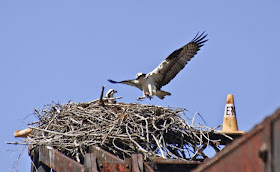Our first clue in the Mystery of Disappearing Seeds was the timing: the feeder became empty during the morning hours. We would fill it up at 8 a.m. and by 11 all was gone.
Time to pay attention!
One morning we saw a flash of yellow ..... we rushed to the window to see an American Goldfinch.
Male goldfinch changes its colour twice a year. In springtime to impress the females;
later on during the summer and fall it moults back to a less conspicuous design - for safety. Back to looking somewhat like a female!
No need for show-off when the breeding is done!
Springtime females are tiny bit more colourful as well (compared to winter) but their plumage is nowhere near as striking as that of the males.
 |
| American Goldfinch - female |
 |
| Pine Siskin |
However, the finches are modest feeders and their numbers this season are not too high. They could not empty the whole thing in two hours.
Not even with help of their Pine Siskin cousins.
Siskins do sport yellow in their wings and they do arrive in large numbers, however they prefer to pick the seeds from the ground.
So who else was there?
Another flash of yellow! Much deeper shade - more of it.
Now, imagine some scary music.
In any case - that never happened before! Not here.
We saw them in the winter, yes, and they were not nearly as colourful as they were in their spring outfits.
Males - as usual - more dressed-up than the females: more yellow, more brown, more everything. What was really neat were their greenish beaks.
Evening Grosbeak,
Coccothraustes vespertinus,
We had seen them during the winter and I posted their portraits in my winter blog.
What a difference!
Sporadic as they are they might arrive to the winter feeders in very large numbers. But seeing them in springtime was a real treat.

As their strong beaks rapidly shelled the seeds a shower of husks and tiny bits of inner meal rained on the ground below.
The little guys knew. Smartly positioned underneath, they waited for their favourite snack.
 How nice of you, cousin finches (grosbeak is a large finch)! You do empty the feeder in no time but there is plenty to pick up from the ground. Thanks for your messy work.
How nice of you, cousin finches (grosbeak is a large finch)! You do empty the feeder in no time but there is plenty to pick up from the ground. Thanks for your messy work.
 How nice of you, cousin finches (grosbeak is a large finch)! You do empty the feeder in no time but there is plenty to pick up from the ground. Thanks for your messy work.
How nice of you, cousin finches (grosbeak is a large finch)! You do empty the feeder in no time but there is plenty to pick up from the ground. Thanks for your messy work.
And so ... they all had a blast!
... UNTIL ...
 She landed on the branch like a bomb.
She landed on the branch like a bomb.One look at the two bachelors and she was on the feeder!
The entire setup began to twirl around like a carousel. Two males, one female.
She picked one.
A smart maneuver and an ambush.
At least - that's what it seemed like to me; a human hiding under a very large umbrella.
She made him feed her! Yes, it does look like a kiss.
Are we humanizing? Who on Earth knows, Science is still so young.
So that was it! Mom and Dad (future Mom and Dad) making a bond.
The Mystery of the Disappearing Seeds has been solved!

As for the grosbeaks - 1 more pair showed up - lingered around for a couple more days and .....disappeared!






















































